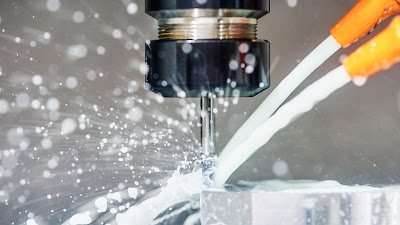Metalworking Fluid is a chemical compound that improves the effectiveness of machining equipment during activities like drilling and grinding.
 |
| Metalworking Fluid |
Metalworking Fluid have exceptional chemical
resistance and are very stable at both high and low temperatures. Metalworking
fluids assist in the reduction of heat, the provision of lubricants, and the
removal of small metal chips generated during the grinding and cutting of metal
components.
Metalworking fluid (MWF) refers to a group of oils and other
liquids used to cool and lubricate metal workpieces while they are being
machined, ground, milled, and so on. MWFs assist avoid burning and smoke by
reducing heat and friction between the cutting tool and the workpiece. By
continually eliminating fines, chips, and swarfs from the tool being used and
the workpiece's surface, MWFs also serve to enhance the quality of the
workpiece. (Swarfs are little fragments of metal that a cutting tool removes
from a workpiece.)
How does the
composition of MWFs change with storage or use?
When a fluid is held for an extended length of time,
nitrosamines can develop. Nitrosamines occur slowly in water-based Metalworking
Fluids and can be
caused by interactions between nitrites in the fluid, the lining of storage
cans, or nitrogen oxides in the air. If more reactants are introduced to
recycled MWFs, the situation will become worse. Because many nitrosamines are
classed as carcinogens, the development of nitrosamines in metalworking fluids
is a problem. When using MWFs, the presence of pollutants that favour the
development of bacteria and fungus in water-based MWFs is a major problem.
Bacteria have the ability to destroy emulsions and alter the characteristics of
MWFs. Biocides are used to control the quantity of microbial development,
however the biocide products themselves have hazardous properties.
Other contaminants include "tramp" oil, which is
used for machine lubrication and includes hydraulic oil, gear box oil, and
other lubricants. Tramp oils that seep into metalworking fluids can help
microbial development in a variety of ways, including as a source of nutrients
for bacteria and as a source of anaerobic microbial growth conditions. Small
metal or alloy items (e.g., fines, chips, swarfs) that come off the components
as they are being machined contaminate MWFs as well. Steel and alloys including
nickel, cobalt, and chromium are commonly utilised.
Different Types of Metalworking Fluids-
·
Straight
Oils: Also known as "neat" or "cutting" oils. Mineral
(petroleum), animal, marine, vegetable, or synthetic oils make up this
category. Mineral oils are now "very solvent refined" or
"extremely hydrotreated." These are words for refining procedures
that assist lower the quantity of polynuclear aromatic hydrocarbons in the
environment (PAHs). Although straight oils are not diluted with water, they may
include additional ingredients.
·
Soluble
Oils (emulsifiable oils): This category comprises emulsifiers to distribute
the oil in water, as well as 30 to 85 percent severely processed petroleum
oils.
·
Semi-synthetic
fluids: This category includes 5 to 30% highly refined petroleum oils, 30
to 50% water, and a variety of additives.
·
Synthetic
fluids: Petroleum oils are not included in this category. To assist
"wet" the workpiece, they utilise detergent-like components and other
additions.
Each of the Category
Contains various additives Like- Sulphurized or chlorinated
compounds.,Corrosion inhibitors (e.g., calcium sulfonate, sodium sulfonates,
fatty acid soaps, amines, boric acid).,Extreme pressure additives (e.g.,
sulfurized fatty materials, chlorinated paraffins, phosphorus derivatives)., Anti-mist
agents (e.g., polyisobutylene polymer).,Anti-weld agents.,Emulsifiers (e.g.,
triethanolamine, sodium petroleum sulphonates, salts of fatty acids and
non-ionic surfactants)., Alkanolamines., Biocides (e.g., triazine compounds,
oxazolidine compounds)., Preservatives., Stabilizers., Dispersants., Defoamer.,
Colourants., Dyes., Odourants., Fragrances.



Comments
Post a Comment